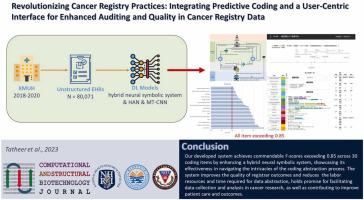当前位置:
X-MOL 学术
›
Comput. Struct. Biotechnol. J.
›
论文详情
Our official English website, www.x-mol.net, welcomes your feedback! (Note: you will need to create a separate account there.)
Integrating predictive coding and a user-centric interface for enhanced auditing and quality in cancer registry data
Computational and Structural Biotechnology Journal ( IF 6 ) Pub Date : 2024-04-07 , DOI: 10.1016/j.csbj.2024.04.007 Hong-Jie Dai , Chien-Chang Chen , Tatheer Hussain Mir , Ting-Yu Wang , Chen-Kai Wang , Ya-Chen Chang , Shu-Jung Yu , Yi-Wen Shen , Cheng-Jiun Huang , Chia-Hsuan Tsai , Ching-Yun Wang , Hsiao-Jou Chen , Pei-Shan Weng , You-Xiang Lin , Sheng-Wei Chen , Ming-Ju Tsai , Shian-Fei Juang , Su-Ying Wu , Wen-Tsung Tsai , Ming-Yii Huang , Chih-Jen Huang , Chih-Jen Yang , Ping-Zun Liu , Chiao-Wen Huang , Chi-Yen Huang , William Yu Chung Wang , Inn-Wen Chong , Yi-Hsin Yang
Computational and Structural Biotechnology Journal ( IF 6 ) Pub Date : 2024-04-07 , DOI: 10.1016/j.csbj.2024.04.007 Hong-Jie Dai , Chien-Chang Chen , Tatheer Hussain Mir , Ting-Yu Wang , Chen-Kai Wang , Ya-Chen Chang , Shu-Jung Yu , Yi-Wen Shen , Cheng-Jiun Huang , Chia-Hsuan Tsai , Ching-Yun Wang , Hsiao-Jou Chen , Pei-Shan Weng , You-Xiang Lin , Sheng-Wei Chen , Ming-Ju Tsai , Shian-Fei Juang , Su-Ying Wu , Wen-Tsung Tsai , Ming-Yii Huang , Chih-Jen Huang , Chih-Jen Yang , Ping-Zun Liu , Chiao-Wen Huang , Chi-Yen Huang , William Yu Chung Wang , Inn-Wen Chong , Yi-Hsin Yang

|
Data curation for a hospital-based cancer registry heavily relies on the labor-intensive manual abstraction process by cancer registrars to identify cancer-related information from free-text electronic health records. To streamline this process, a natural language processing system incorporating a hybrid of deep learning-based and rule-based approaches for identifying lung cancer registry-related concepts, along with a symbolic expert system that generates registry coding based on weighted rules, was developed. The system is integrated with the hospital information system at a medical center to provide cancer registrars with a patient journey visualization platform. The embedded system offers a comprehensive view of patient reports annotated with significant registry concepts to facilitate the manual coding process and elevate overall quality. Extensive evaluations, including comparisons with state-of-the-art methods, were conducted using a lung cancer dataset comprising 1428 patients from the medical center. The experimental results illustrate the effectiveness of the developed system, consistently achieving F1-scores of 0.85 and 1.00 across 30 coding items. Registrar feedback highlights the system’s reliability as a tool for assisting and auditing the abstraction. By presenting key registry items along the timeline of a patient’s reports with accurate code predictions, the system improves the quality of registrar outcomes and reduces the labor resources and time required for data abstraction. Our study highlights advancements in cancer registry coding practices, demonstrating that the proposed hybrid weighted neural-symbolic cancer registry system is reliable and efficient for assisting cancer registrars in the coding workflow and contributing to clinical outcomes.
中文翻译:

集成预测编码和以用户为中心的界面,以增强癌症登记数据的审核和质量
基于医院的癌症登记处的数据管理在很大程度上依赖于癌症登记员的劳动密集型手动提取过程,以从自由文本电子健康记录中识别与癌症相关的信息。为了简化这一过程,开发了一种自然语言处理系统,结合了基于深度学习和基于规则的方法来识别肺癌登记相关概念,以及基于加权规则生成登记编码的符号专家系统。该系统与医疗中心的医院信息系统集成,为癌症登记员提供患者旅程可视化平台。嵌入式系统提供了患者报告的全面视图,并附有重要的注册概念,以促进手动编码过程并提高整体质量。使用包含来自该医疗中心的 1428 名患者的肺癌数据集进行了广泛的评估,包括与最先进的方法进行比较。实验结果说明了所开发系统的有效性,在 30 个编码项目中一致实现了 0.85 和 1.00 的 F1 分数。注册商的反馈强调了系统作为辅助和审计抽象工具的可靠性。通过沿着患者报告的时间线呈现关键登记项目以及准确的代码预测,该系统提高了登记结果的质量,并减少了数据抽象所需的劳动力资源和时间。我们的研究强调了癌症登记编码实践的进步,证明所提出的混合加权神经符号癌症登记系统对于在编码工作流程中协助癌症登记员并为临床结果做出贡献是可靠且有效的。
更新日期:2024-04-07
中文翻译:

集成预测编码和以用户为中心的界面,以增强癌症登记数据的审核和质量
基于医院的癌症登记处的数据管理在很大程度上依赖于癌症登记员的劳动密集型手动提取过程,以从自由文本电子健康记录中识别与癌症相关的信息。为了简化这一过程,开发了一种自然语言处理系统,结合了基于深度学习和基于规则的方法来识别肺癌登记相关概念,以及基于加权规则生成登记编码的符号专家系统。该系统与医疗中心的医院信息系统集成,为癌症登记员提供患者旅程可视化平台。嵌入式系统提供了患者报告的全面视图,并附有重要的注册概念,以促进手动编码过程并提高整体质量。使用包含来自该医疗中心的 1428 名患者的肺癌数据集进行了广泛的评估,包括与最先进的方法进行比较。实验结果说明了所开发系统的有效性,在 30 个编码项目中一致实现了 0.85 和 1.00 的 F1 分数。注册商的反馈强调了系统作为辅助和审计抽象工具的可靠性。通过沿着患者报告的时间线呈现关键登记项目以及准确的代码预测,该系统提高了登记结果的质量,并减少了数据抽象所需的劳动力资源和时间。我们的研究强调了癌症登记编码实践的进步,证明所提出的混合加权神经符号癌症登记系统对于在编码工作流程中协助癌症登记员并为临床结果做出贡献是可靠且有效的。



























 京公网安备 11010802027423号
京公网安备 11010802027423号